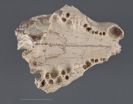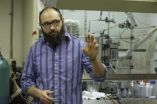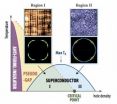(Press-News.org) Eating more fruits and vegetables may reduce the risk of stroke worldwide, according to new research in the American Heart Association's journal Stroke.
Researchers conducted a meta-analysis of 20 studies published over the last 19 years to assess the effects of fruit and vegetable consumption on risk of stroke globally. The combined studies involved 760,629 men and women who had 16,981 strokes.
Stroke risk decreased by 32 percent with every 200 grams of fruit consumed each day and 11 percent with every 200 grams of vegetables consumed each day.
"Improving diet and lifestyle is critical for heart and stroke risk reduction in the general population," said Yan Qu, M.D., the study's senior author, director of the intensive care unit at Qingdao Municipal Hospital and professor at the Medical College of Qingdao University in Qingdao, China. "In particular, a diet rich in fruits and vegetables is highly recommended because it meets micronutrient and macronutrient and fiber requirements without adding substantially to overall energy requirements."
Macronutrients (carbohydrates, protein and fat) provide calories or energy. Our bodies need smaller amounts of micronutrients such as vitamins and minerals.
The researcher cited studies demonstrating that high fruit and vegetable consumption can lower blood pressure and improve microvascular function. It has favorable effects on body mass index, waist circumference, cholesterol, inflammation and oxidative stress.
The beneficial effects of fruits and vegetables applied consistently to men and women, stroke outcome and by type of stroke (caused by clot or bleeding). Researchers found no significant difference in the effect on age (younger or older than 55).
The researchers adjusted the study findings for factors such as smoking, alcohol, blood pressure, cholesterol, physical activity, body mass index and other dietary variables.
Researchers combined the results of six studies from the United States, eight from Europe and six from Asia (China and Japan). They note that low fruit and vegetable consumption is prevalent worldwide, and especially in low- and middle-income countries.
Increasing the consumption of fruits and vegetables up to 600 grams each day could reduce the burden of ischemic stroke by 19 percent globally, according to the World Health Organization.
In China, stroke is the leading cause of death, with an estimated 1.7 million people dying in 2010. In the United States, stroke is the No. 4 cause of death and a leading cause of disability.
The American Heart Association advises the average adult to eat four to five servings each of fruits and vegetables daily, based on a 2,000-calorie diet. A diet rich in a variety of colors and types of vegetables and fruits is a way of getting important nutrients that most people don't get enough of, including vitamins, minerals, and dietary fiber. They are also naturally low in saturated fat.
INFORMATION:
Co-authors are Dan Hu, M.D.; Jungian Huang, M.D.; Yuchun Wang, M.D.; Dongfeng Zhang, M.D. Author disclosures are on the manuscript.
The The Qingdao Municipal Hospital funded the study.
Additional Resources:
May is American Stroke Month
Eat More Fruits and Vegetables.
Follow the AHA/ASA news on Twitter @HeartNews.
For stroke science, follow the Stroke journal at @StrokeAHA_ASA
Statements and conclusions of study authors published in American Heart Association scientific journals are solely those of the study authors and do not necessarily reflect the association's policy or position. The association makes no representation or guarantee as to their accuracy or reliability. The association receives funding primarily from individuals; foundations and corporations (including pharmaceutical, device manufacturers and other companies) also make donations and fund specific association programs and events. The association has strict policies to prevent these relationships from influencing the science content. Revenues from pharmaceutical and device corporations are available at http://www.heart.org/corporatefunding.
Eating more fruits, vegetables may cut stroke risk worldwide
American Heart Association Rapid Access Journal Report
2014-05-08
ELSE PRESS RELEASES FROM THIS DATE:
Common test used on heart patients who need defibrillator implants unnecessary: Study
2014-05-08
Hamilton, ON (May 8, 2014) – New research from McMaster University suggests that a commonly performed test during certain types of heart surgery is not helpful and possibly harmful.
The testing procedure, known as defibrillator testing (DT), is commonly used on people who require implantable cardioverter-defibrillators (ICDs) to prevent sudden cardiac death. It involves putting the patient into cardiac arrest to determine if the defibrillator can first recognize, then successfully shock the patient back into a normal heart rhythm. It requires the use of general anesthesia ...
Study confirms mitochondrial deficits in children with autism
2014-05-08
(SACRAMENTO, Calif.) — Children with autism experience deficits in a type of immune cell that protects the body from infection. Called granulocytes, the cells exhibit one-third the capacity to fight infection and protect the body from invasion compared with the same cells in children who are developing normally.
The cells, which circulate in the bloodstream, are less able to deliver crucial infection-fighting oxidative responses to combat invading pathogens because of dysfunction in their tiny energy-generating organelles, the mitochondria.
The study is published ...
Mid-level solar flare erupts from the sun
2014-05-08
The sun emitted a mid-level solar flare, peaking at 6:07 a.m. EDT on May 8, 2014, and NASA's Solar Dynamics Observatory, or SDO, captured images of it. Solar flares are powerful bursts of radiation. Harmful radiation from a flare cannot pass through Earth's atmosphere to physically affect humans on the ground, however -- when intense enough -- they can disturb the atmosphere in the layer where GPS and communications signals travel.
To see how this event may impact Earth, please visit NOAA's Space Weather Prediction Center at http://spaceweather.gov, the U.S. government's ...
JCI online ahead of print table of contents for May 8, 2014
2014-05-08
Leptin-dependent regulation of reproduction
Individuals that lack the adipose-derived hormone leptin fail to complete puberty and are infertile. Leptin-deficient mice recapitulate human phenotypes; however, it is not clear how leptin and leptin signaling impact the reproductive axis. In this issue of the Journal of Clinical Investigation, Vincent Prevot and colleagues at INSERM U837 evaluated leptin deficient animals and determined that leptin acts directly on neurons in the preoptic region of the hypothalamus that synthesize nitric oxide to regulate peripheral levels ...
Regenerating plastic grows back after damage
2014-05-08
CHAMPAIGN, Ill. — Looking at a smooth sheet of plastic in one University of Illinois laboratory, no one would guess that an impact had recently blasted a hole through it.
Illinois researchers have developed materials that not only heal, but regenerate. Until now, self-repairing materials could only bond tiny microscopic cracks. The new regenerating materials fill in large cracks and holes by regrowing material.
Led by professor Scott White, the research team comprises professors Jeffry S. Moore and Nancy Sottos and graduate students Brett Krull, Windy Santa Cruz and ...
Extinct kitten-sized hunter discovered
2014-05-08
A Case Western Reserve University student and his mentor have discovered an ancient kitten-sized predator that lived in Bolivia about 13 million years ago—one of the smallest species reported in the extinct order Sparassodonta.
Third-year undergraduate student Russell Engelman and Case Western Reserve anatomy professor Darin Croft made the finding by analyzing a partial skull that had been in a University of Florida collection more than three decades.
The researchers report their finding in the Journal of Vertebrate Paleontology online at: http://www.tandfonline.com/doi/full/10.1080/02724634.2013.827118#.U2p8-S8njhM.
"The ...
Fueling aviation with hardwoods
2014-05-08
A key challenge in the biofuels landscape is to get more advanced biofuels—fuels other than corn ethanol and vegetable oil-based biodiesel—into the transportation pool. Utilization of advanced biofuels is stipulated by the Energy Independence and Security Act; however, current production levels lag behind proposed targets. Additionally, certain transportation sectors, such as aviation, are likely to continue to require liquid hydrocarbon fuels in the long term even as light duty transportation shifts to alternative power sources. A multi-university team lead by George ...
Chemotherapy timing is key to success
2014-05-08
CAMBRIDGE, Mass-- MIT researchers have devised a novel cancer treatment that destroys tumor cells by first disarming their defenses, then hitting them with a lethal dose of DNA damage.
In studies with mice, the research team showed that this one-two punch, which relies on a nanoparticle that carries two drugs and releases them at different times, dramatically shrinks lung and breast tumors. The MIT team, led by Michael Yaffe, the David H. Koch Professor in Science, and Paula Hammond, the David H. Koch Professor in Engineering, describe the findings in the May 8 online ...
Climate change may worsen summertime ozone pollution
2014-05-08
Ozone pollution across the continental United States will become far more difficult to keep in check as temperatures rise, according to new research results.
The study shows that Americans face the risk of a 70 percent increase in unhealthy summertime ozone levels by 2050.
The results appear online this week in a paper in the Journal of Geophysical Research-Atmospheres, published by the American Geophysical Union.
The work was funded by the National Science Foundation (NSF) and the U.S. Department of Energy.
Warmer temperatures and other changes in the atmosphere ...
Scientists find solution to 2 long-standing mysteries of cuprate superconductivity
2014-05-08
UPTON, NY—Scientists seeking to understand the intricacies of high-temperature superconductivity—the ability of certain materials to carry electrical current with no energy loss—have been particularly puzzled by a mysterious phase that emerges as charge carriers are added that appears to compete with superconductivity. It's also been a mystery why, within this "pseudogap" phase, the movement of superconducting electrons appears to be restricted to certain directions. So exploring the pseudogap and whether and how it affects the movement of electrons has been a pivotal challenge. ...
LAST 30 PRESS RELEASES:
Tracing the quick synthesis of an industrially important catalyst
New software sheds light on cancer’s hidden genetic networks
UT Health San Antonio awarded $3 million in CPRIT grants to bolster cancer research and prevention efforts in South Texas
Third symposium spotlights global challenge of new contaminants in China’s fight against pollution
From straw to soil harmony: International team reveals how biochar supercharges carbon-smart farming
Myeloma: How AI is redrawing the map of cancer care
Manhattan E. Charurat, Ph.D., MHS invested as the Homer and Martha Gudelsky Distinguished Professor in Medicine at the University of Maryland School of Medicine
Insilico Medicine’s Pharma.AI Q4 Winter Launch Recap: Revolutionizing drug discovery with cutting-edge AI innovations, accelerating the path to pharmaceutical superintelligence
Nanoplastics have diet-dependent impacts on digestive system health
Brain neuron death occurs throughout life and increases with age, a natural human protein drug may halt neuron death in Alzheimer’s disease
SPIE and CLP announce the recipients of the 2025 Advanced Photonics Young Innovator Award
Lessons from the Caldor Fire’s Christmas Valley ‘Miracle’
Ant societies rose by trading individual protection for collective power
Research reveals how ancient viral DNA shapes early embryonic development
A molecular gatekeeper that controls protein synthesis
New ‘cloaking device’ concept to shield sensitive tech from magnetic fields
Researchers show impact of mountain building and climate change on alpine biodiversity
Study models the transition from Neanderthals to modern humans in Europe
University of Phoenix College of Doctoral Studies releases white paper on AI-driven skilling to reduce burnout and restore worker autonomy
AIs fail at the game of visual “telephone”
The levers for a sustainable food system
Potential changes in US homelessness by ending federal support for housing first programs
Vulnerability of large language models to prompt injection when providing medical advice
Researchers develop new system for high-energy-density, long-life, multi-electron transfer bromine-based flow batteries
Ending federal support for housing first programs could increase U.S. homelessness by 5% in one year, new JAMA study finds
New research uncovers molecular ‘safety switch’ shielding cancers from immune attack
Bacteria resisting viral infection can still sink carbon to ocean floor
Younger biological age may increase depression risk in older women during COVID-19
Bharat Innovates 2026 National Basecamp Showcases India’s Most Promising Deep-Tech Ventures
Here’s what determines whether your income level rises or falls
[Press-News.org] Eating more fruits, vegetables may cut stroke risk worldwideAmerican Heart Association Rapid Access Journal Report





